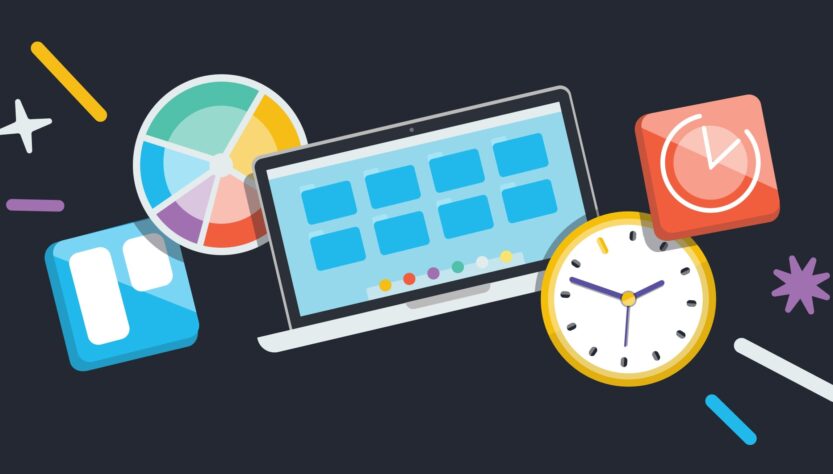(Image credit: Pexels)
The best time management apps provide a simple way to manage time, and tasks, and improve productivity goals for yourself or your employees.
This is important because time management is an essential skill to learn when involved with running a business, department, or other managerial duties.
This is especially because there are never enough hours in the day to do everything, so it’s important to be able to prioritize tasks and keep track of your time, so you don’t get sucked into spending too long on just one task at the expense of others.
However, there are apps and software you can use to help with time management, ensuring that you organize your time more efficiently and effectively.
Most of the apps we looked at offer individual as well as team tracking and provide features for tracking time, not least for counting billable time, internet use, and time spent on an individual project. Some have goals built into them, or general analysis of time used through the day, to help you better identify time sinks and lazy periods when you can be more productive.
Where team features are available, this allows you to compare your own performance with others from your team and use insights into how not just better to manage your own time but how others in the team can learn from each other to do the same.

Best time management apps in 2023 in full:
Why you can trust TechRadar, Our expert reviewers spend hours testing and comparing products and services so you can choose the best for you.
1. Timecamp

REASONS TO BUY
- Integrated attendance tracker+
- Automated time tracking
REASONS TO AVOID
- Free tier is limited to a single user
Timecamp has a number of simple-to-use functions related to time tracking aimed at maximizing team productivity. The feature set includes billable time tracking, sending invoices based on time spent, an attendance tracker, and team time tracking. It also can integrate with over 50 productivity tools for ease of use, including Slack, Jira, and Evernote.
There is also Automatic Time Tracking which can be used for employee internet usage monitoring, and to assign an entry to the correct project. The time management software function puts this all together to be able to track a team’s time spent on a project and also their productivity.
There is a free tier for limited use as it only supports a single user. The next higher plan is the Basic tier, which has no limit on the number of users, supports billable time functions, and offers both a monthly or annual subscription.
2. TMetric
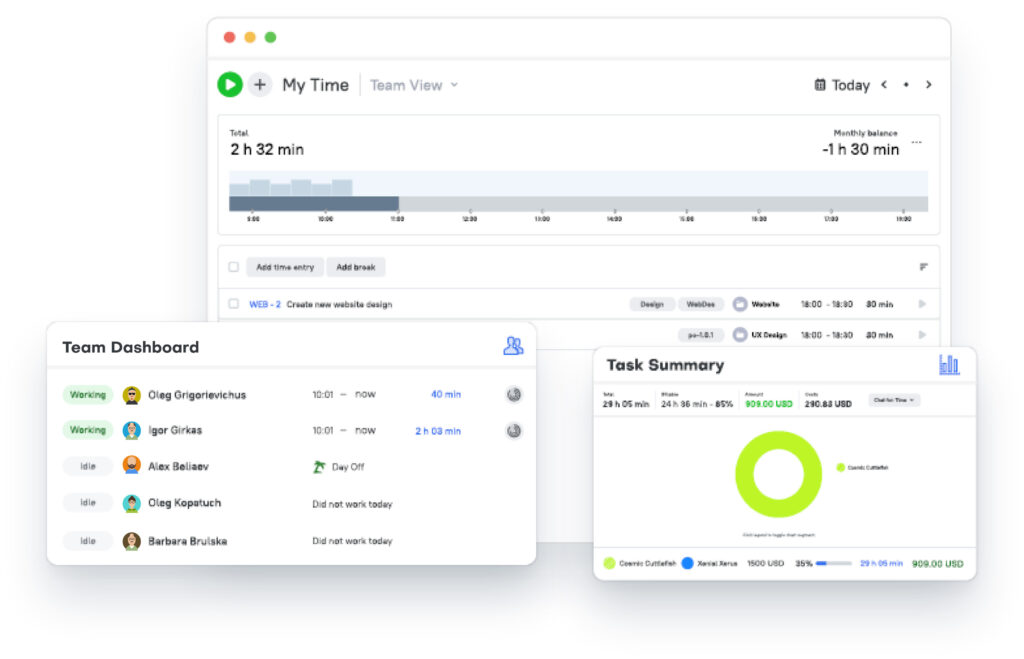
- Best for multiple currency support
REASONS TO BUY
- Browser add-ons for automated data capture+
- Multiple currency support
REASONS TO AVOID
- Free tier does not support invoicing.
For freelancers and companies alike, Tmetric dubs itself a ‘work time tracker,’ which, via a clean interface, provides “great control over time intervals and project budgets.” The key is a visual timeline that gives insight into the activities throughout the day, which you can turn into billable hours. Tmetric boasts over 40,000 users and over nine million hours of time tracked.
The process can be automated as there are browser add-ons to directly and seamlessly capture every minute of data to feed back into Tmetric, which is then tracked, to totally capture each and every billable minute.
Furthermore, there is support for different currencies and the ability to track costs per team, to help maximize income while keeping projects within a predefined budget. Finally, tasks can be tracked by individual team members to follow their productivity and compare to their peers.
This flexible time management app has a free tier that supports up to 5 users. The Professional tier is available, which adds billable rates, invoicing, and to-do lists. The top tier Business plan adds Timesync with Jira and Redmine and can provide cost rates for employees. Both paid plans have a 30-day free trial available, and there are discounts for annual subscriptions.
3. RescueTime
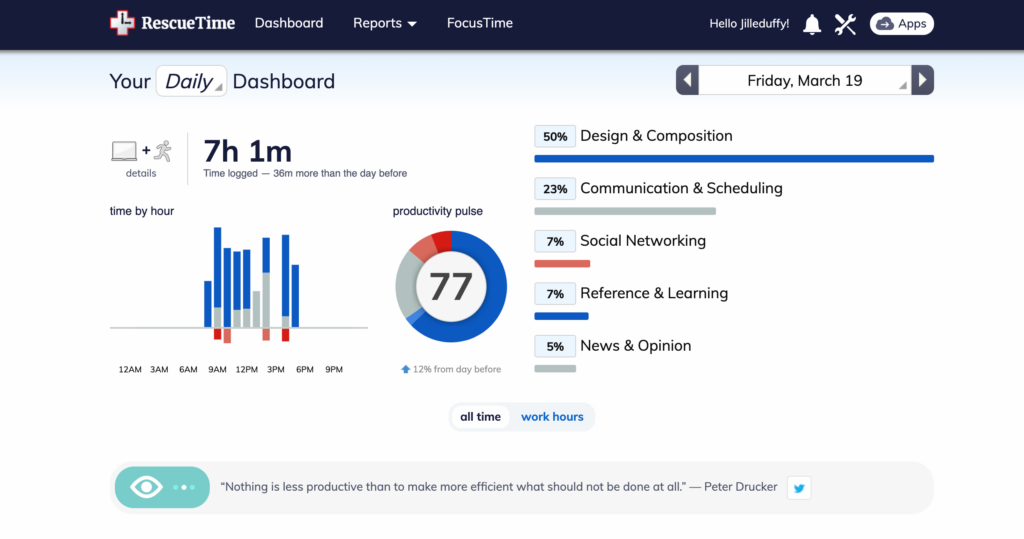
Perfect if you need a tool to help you focus
REASONS TO BUY
- Task-based alerts+
- Blocks distracting websites+
- Free tier
REASONS TO AVOID
- Short trial of premium tier
RescueTime has the laudable goal of eliminating distractions and focusing on productivity. It is quite feature-rich and allows you to set goals, providing each user with feedback such as alerts when daily goals have been met.
There is a free plan called RescueTime Lite that can track time used on websites, set goals, and even provides a weekly email report. More serious time management aficionados can step up to the sole choice of a paid plan known as RescueTime Premium.
RescueTime tracks what you’re working on and will let you know if you’re trying to do too much at once or otherwise losing focus. We think it’s one of the best time management apps for helping you stay on task.
The paid plan builds on the free offering with additional features, including tracking time away from the computer (such as phone calls), keeping a log of daily accomplishments, and the ability to block distracting websites. There is a free 14-day trial for the paid tier.
4. Toggl Track
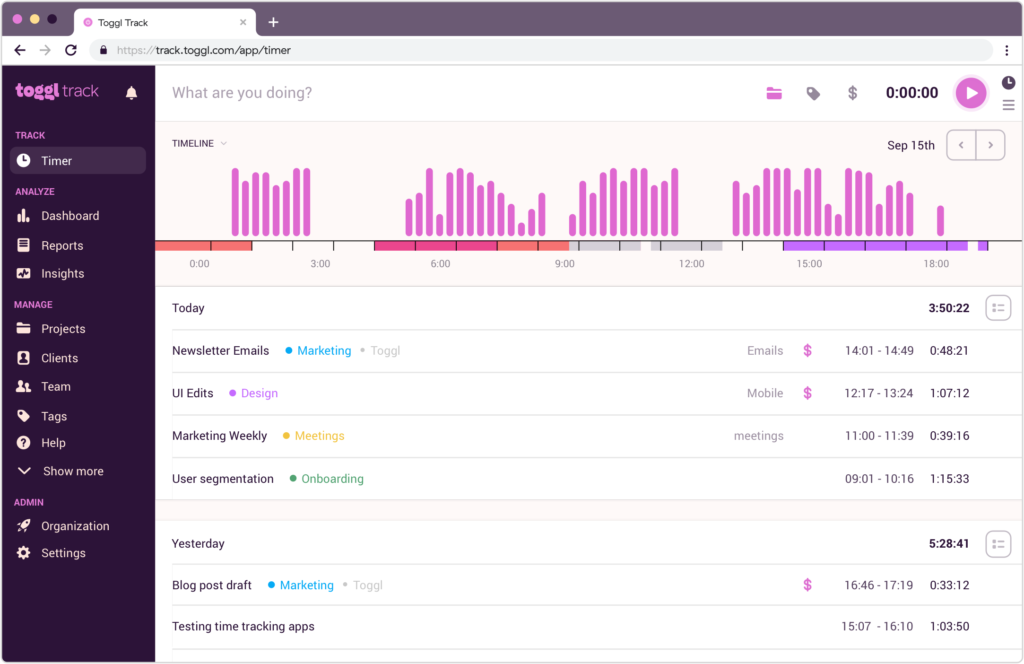
Best for seamless time tracking across multiple devices
REASONS TO BUY
- Cross-platform support+
- Free tier and trial available
REASONS TO AVOID
- No support for invoicing
Toggl takes a simplistic approach to time management, with included tracking reminders and idle detection to make sure the job gets done. It also has cross-platform support, so for example, time tracking can begin in the browser of a desktop PC and then be stopped on a smartphone with time entries synced between devices; there are mobile apps and browser extensions to accomplish this.
Toggl also makes it simple to break down your hours worked by either the project, by the client or by the task, and can then analyze them to determine which is making the best return for the hours spent to facilitate maximizing profits. The Toggl app is simple, but unfortunately, it does not support invoicing.
There is a 30-day free trial for the paid tiers, and a Basic level is available for up to 5 team members. For managing the time of larger groups, the Starter level has no limit to the number of users.
5. Chrometa
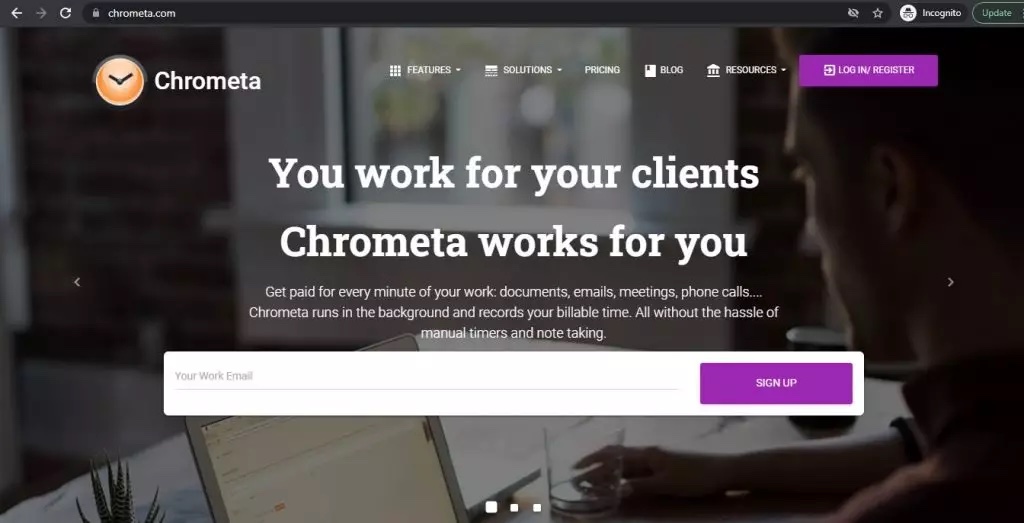
Perfect if you need to track time on mobile devices too
REASONS TO BUY
- Available mobile apps+
- Captures time spent on a variety of apps
REASONS TO AVOID
- No free tier
Wonder no more “where the day has gone” with the Chrometa software that can automatically capture the tasks that you and your team work on. It does this by capturing the URL of the website that you visit, the subject and addressee information from an email, and the file info when working on a local file – and stops the clock when you go away from the computer.
This time management app also captures, via Android and iOS apps, phone calls and text messages to turn time on a mobile device into billable time as well. Seriously, Chrometa is a billing manager’s dream for their office.
There is the offer of a 30-day free trial, but no free plan. The paid subscriptions start with support for a single individual and up to six connected devices – it also provides an hour-long personal training session. There are team plans available as well.
6. ManicTime
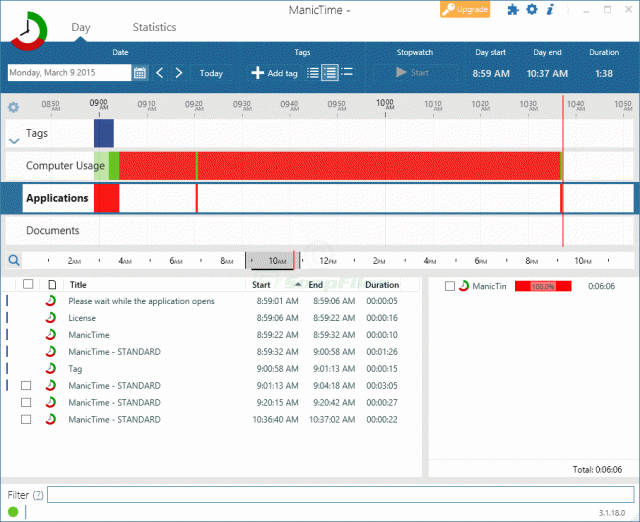
Best for data security
REASONS TO BUY
- Not cloud-based+
- Works without a data connection+
- Free tier
REASONS TO AVOID
- No integration with mobile apps
Do you need a time management app that allays your privacy concerns about sending data cloud-wards? ManicTime is downloadable software that is run locally and keeps its data local and does not connect to some remote server.
Just like some other cloud-based solutions, it can automatically keep track of time spent, whether on a local file or through a website. ManicTime also integrates with task-based systems like Github or Jira.
For an individual plan, there is a free tier that offers basic functionality or the Pro tier, which includes a year of software upgrades.
ManicTime makes it easy to turn your tracked hours into custom reports, presenting any additional data you might require. These are formatted and ready for import into your preferred spreadsheet or invoicing software.
If you like using ManicTime but decided you’d prefer a time management app with cloud functionality, there’s a cloud-based version too.
7. Todoist
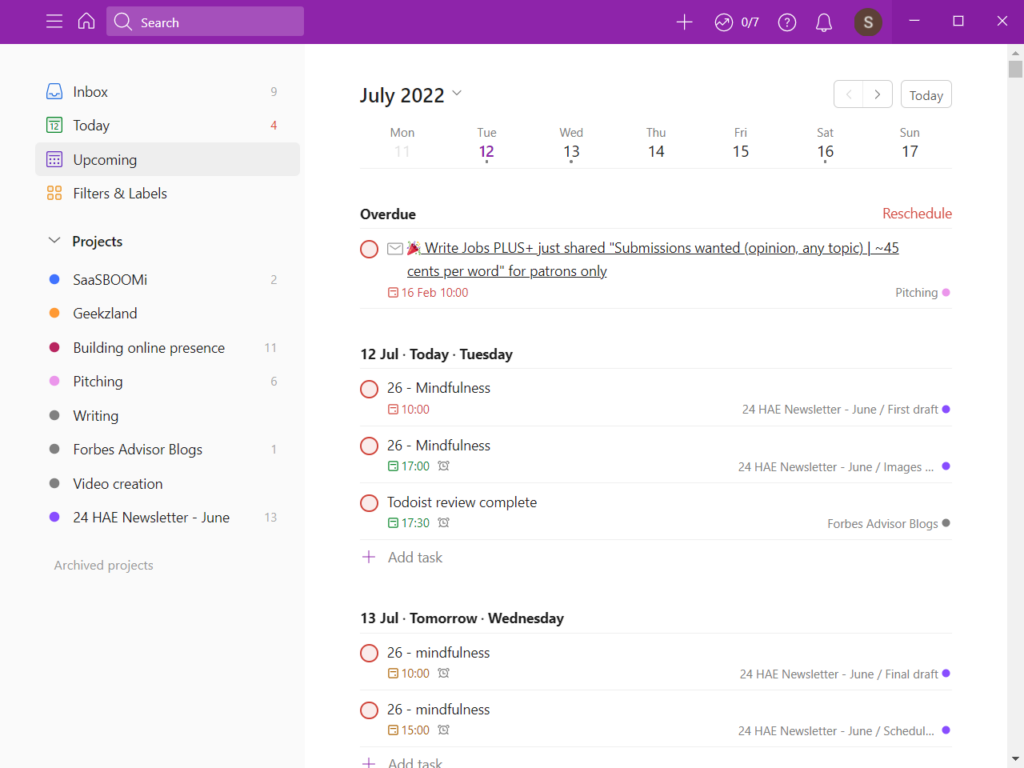
Perfect if you’re looking for a lightweight time-tracking app
REASONS TO BUY
Simple but effective+
Organize projects
REASONS TO AVOID
- Lightweight tool
Ticking off items on a to-do list is hugely satisfying and is a time-honored way to manage your time and get more done during the day.
Todoist is a simple but effective tool for desktop and mobile that lets you set recurring events and essential one-off tasks and check them off once they’re complete. You’ll receive a schedule of jobs at the start of each day (unless you choose not to), enabling you to plan your time effectively.
Tasks are collected in groups called ‘Projects’, though these might be more accurately called ‘Activities’. The default options include shopping, personal, errands, and work, and you can add or edit them to suit you.
Some features are exclusive to the premium version, and unfortunately, you won’t always know until you try to select one, but the free version has plenty of tools to help you achieve more every day.
If you’re looking for a more heavy-duty tool for tasks with multiple parts and deadlines, take a look at Trello. It’s generally a better tool for business use, whereas Todoist is perfect for your own personal tasks.
More time management software options
There are a lot of software apps available for different aspects of accounts and productivity, and time management is no different. Here we’ll feature a selection of additional platforms worth considering as well as those above:
Clockify(opens in new tab) is a simple time tracker and timesheet app for teams that has the distinction of also being free. While that usually means a trade-off in terms of features, Clockify manages to retain essential functionality. Aside from a time tracker and timesheets, it also provides the ability to set up and manage projects and teams, as well as a dashboard to provide an overview of projects as well as analytics based on use.
FocusBooster(opens in new tab) is another paid time management app that offers simple time tracking as well as a to-do list and productivity reports. However, it takes a more unique approach in encouraging work in small bursts with breaks in between so that you can balance work with life and play. There’s a free tier available, but even paid pricing remains relatively cheap, from $2.99 to $4.99 per month, depending on the number of features required.
Tick(opens in new tab) offers a more advanced time tracking solution for specifically working with teams, and offers mobile apps for use with Android and iOS as well as for desktop PCs. At its core is a time track which allows managers to then track budgets and profitability. Tick can also be integrated with other productivity software, such as Basecamp.
HubStaff(opens in new tab) is another managerial time-tracking solution, offering a wide range of features such as timesheets, GPS tracking, team scheduling, productivity monitoring, and of course, reporting for insights. You can import projects or start new ones and begin time tracking from then. There’s also a wide range of integrations available, from Asana to Zoho Projects.
What is a time management app?
Time management apps come in various shapes and sizes, but they all have one thing in common. They track the time that you spend on activities you wish to track.
This is useful for businesses tracking hours worked by remote staff, or for freelancers who need to know how many hours they have spent working on a particular project.
Beyond tracking hours, some time tracking apps can automatically generate invoices, give you tips on working more efficiently, and even warn you if you’re losing focus.
How to choose the best time management app for you
Choosing the best time management app for you starts with understanding how you want to use the data captured. If you want to track your own work and have no need for integration with other software, a no-frills free time tracker could be all you ever need.
Individuals who want an app that keeps them focused and helps with invoicing would be better served by a more advanced app. Similarly, business users who wish to track multiple employees will benefit from a cloud-based time management app with enhanced reporting features.
The best time management apps: How we test
To test for the best time management apps, we first set up an account with the relevant software platform, whether as a download or as an online service. We then tested the service to see how the software could be used for different purposes and in different situations. The aim was to push each software platform to see how useful its basic tools were and how easy it was to get to grips with any more advanced tools.
